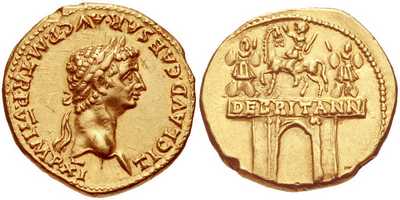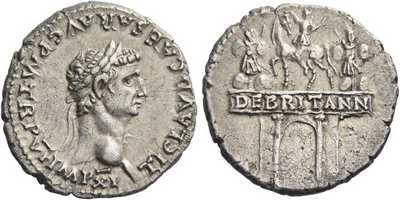| Back to Roman Coins About Britain | This page is part of the article Roman Coins About Britain | Forward to Vespasian and Titus |
The Roman conquest of Britain started in 55 BC when Julius Caesar popped across the channel, made a lot of noise, and left again, but the first mention of Britain on a coin wasn’t until 46 AD when Claudius put a triumphal arch and “De Britann” on some coins to show he had conquered the island and added it to the Roman empire.
Claudius accidentally became emperor in 41 AD (funny story – he was hiding behind a curtain while the Praetorian guard were assassinating the emperor Caligula and his family, when another Praetorian guard found him and declared him emperor. It was possibly a set-up) and needed something to cement his power. One of his early acts was to invade Britain in 43 AD. By 46 AD this had progressed far enough for him to celebrate his victory, and two triumphal arches were erected for him; one in Rome and one in Gaul. These arches were commemorated on Aurei and Denarii.
Aurei from 46-47 AD (two issues), 49-50 AD, and 50-51 AD survive. Denarii from 46-47 AD and 49-50 AD survive.
| 46-47 AD | 49-50 AD | 50-51 AD |
|---|---|---|
| RIC 1 30 – Aureus | RIC 1 44 – Aureus | Not in RIC – Aureus |
| RIC 1 33 – Aureus | RIC 1 45 – Denarius | |
| RIC 1 34 – Denarius |
Claudius also minted a didrachm (RIC 1 122) at the Caesarea mint in Cappadocia. This coin features Claudius in a quadriga, and has the reverse legend “DE BRITANNIS”. It’s undated, but is assumed to refer to his victory in Britain. RIC puts it as circa 45AD, this book says 46-48AD, and CNG say it was struck circa 43-48 AD. They also say it shows “Claudius returning triumphantly from Britain”. RIC 2 puts it as circa 45AD, this book says 46-48AD, and CNG say it was struck circa 43-48 AD. They also say it shows “Claudius returning triumphantly from Britain”.
Intriguingly, this coin might not be related to his victories in Britain at all, but instead might be a celebration of the upcoming war in Britain. There are clues to this in the obverse legend “TI CLAVDIVS CAESAR AVG GERM P M TR P”
- “GERM” is short for Germanicus, which is a title he only used at the Rome mint in 41-42 AD
- “TR P” refers to his first “Tribunicia Potestate” (Tribunician power; the power to veto legislation) which was awarded annually. His first Tribunicia Potestate ran from the 25th of January 41 AD to the 24th of January 42AD.
- Claudius became Imperator for the tenth and eleventh time in 46-47 AD because of the victories in Britain. His coins from the mint in Rome started to include “IMP X” and “IMP XI” as a result, and it’s strange that this would be missing on a contemporary coin celebrating his victory in Britain.
It’s possible that the Caesarea mint were just using a legend that was three or four years out of date, but if not, then this coin dates to 41-42AD.
Article Navigation
| Back to Roman Coins About Britain | Up to Roman Coins About Britain | Forward to Vespasian and Titus |



